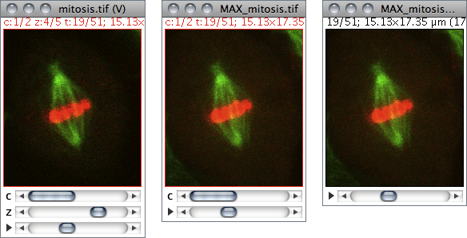8 Stacks, Virtual Stacks and Hyperstacks
Stacks
ImageJ can display multiple spatially or temporally related images in a single window. These image sets are called stacks. The images that make up a stack are called slices. In stacks, a pixel (which represents 2D image data in a bitmap image) becomes a voxel[?] (volumetric pixel), i.e., an intensity value on a regular grid in a three dimensional space.
All the slices in a stack must be the same size and bit depth. A scrollbar provides the ability to move through the slices and the slider is preceded by a play/pause icon that can be used to start/stop stack animation. Right-clicking on this icon runs the dialog box.
Most ImageJ filters will, as an option, process all the slices in a stack. ImageJ opens multi-image TIFF files as a stack, and saves stacks as multi-image TIFFs. The command opens other multi-image, uncompressed files. A folder of images can be opened as a stack either by dragging and dropping the folder onto the ‘ImageJ’ window or or by choosing To create a new stack, simply choose and set the Slices field to a value greater than one. The submenu contains commands for common stack operations.


Figure 2 Stacks and Hyperstacks in ImageJ: . Hyperstacks dimensionality can be reduced using , or . The ‘(V)’ on the window title denotes a virtual image (see Virtual Stacks↓).
Stacks Menu↓, Stack Manipulations on Fiji website, Image5D
Virtual Stacks
Virtual stacks are disk resident (as opposed to RAM[?] resident) and are the only way to load image sequences that do not fit in RAM. There are several things to keep in mind when working with virtual stacks:
- Virtual stacks are read-only, so changes made to the pixel data are not saved when you switch to a different slice. You can work around this by using macros (e.g., Process Virtual Stack) or the command
- You can easily run out of memory using commands like because any stack generated from commands that do not generate virtual stacks will be RAM resident.
- TIFF virtual stacks can usually be accessed faster than JPEG virtual stacks. A JPEG sequence can be converted to TIFF by opening the JPEG images as a virtual stack and using to save in TIFF format
ImageJ appends a ‘(V)’ to the window title of virtual stacks and hyperstacks (see Hyperstacks↓). Several built-in ImageJ commands in the submenu have the ability to open virtual stacks, namely: , , , , (cf. Virtual Stack Opener). In addition, TIFF stacks can be open as virtual stacks by drag and drop (cf. 4: Opening Virtual Stacks by Drag & Drop↓).
LOCI Bio-Formats and RegisterVirtualStackSlices plugins, Process Virtual Stack and VirtualStackFromList macros
Hyperstacks
Hyperstacks are multidimensional images, extending image stacks to four (4D) or five (5D) dimensions: x (width), y (height), z (slices), c (channels or wavelengths) and t (time frames). Hyperstacks are displayed in a window with three labelled scrollbars (see Stacks and Hyperstacks↑). Similarly to the scrollbar in Stacks↑, the frame slider (t) has a play/pause icon.
submenu

